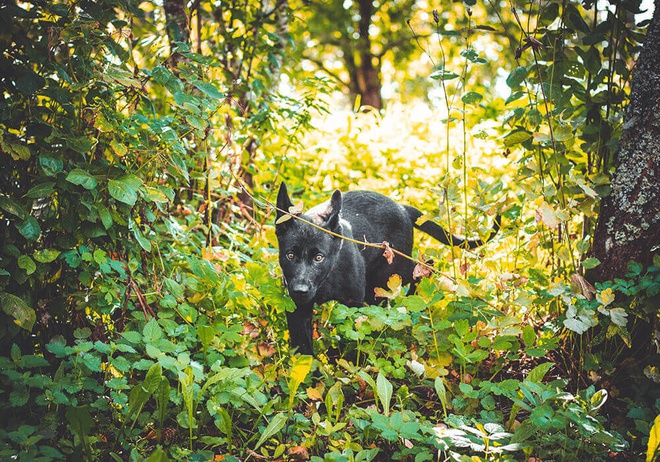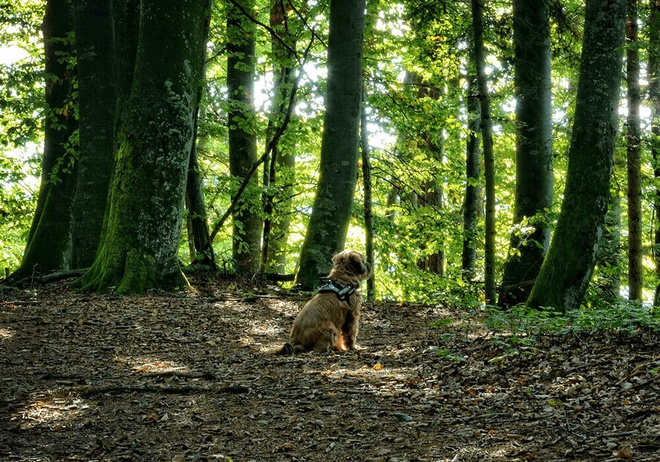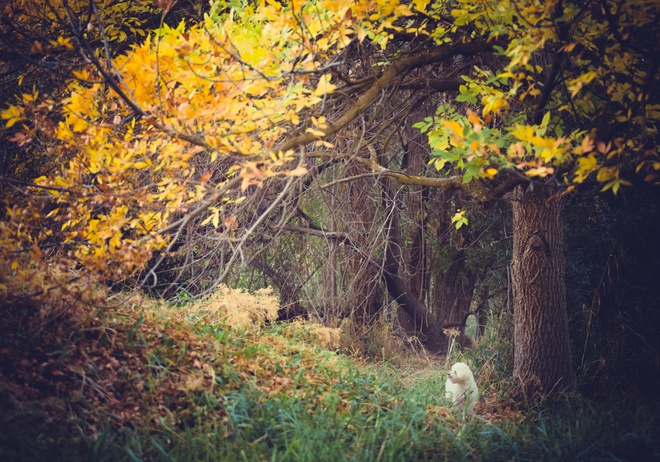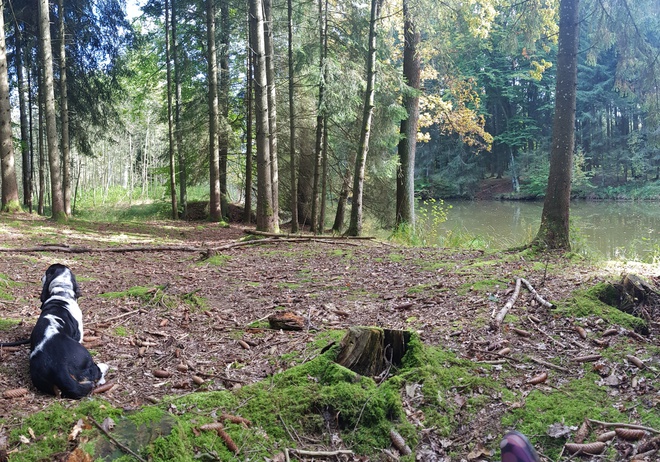How can I find a lost dog in the woods?
Imagine this scenario: you're enjoying a nice hike with your pet in a familiar forest. You stop to catch your breath, take your pack off, and sip cold stream water from your canteen. You look around, and suddenly it dawns on you: your pet is nowhere to be seen.
You panic and start calling his name, but there's no answer. You backtrack and look around a giant bolder off the trail, hoping to catch a glimpse of his yellow fur or hear him panting. You're alone in the woods with no clue where your dog is.

Reading time : 5 min
If this sounds like a nightmare, it's unfortunately a reality for many outdoor enthusiasts who lose their dogs in the woods every year. Whether it's due to curiosity about a distant sound, fear, or just chasing a squirrel, canines can easily wander off and get lost in the wilderness. And finding them can be challenging.
But don't lose hope! We want to offer you some strategies you can use to increase your chances of finding your lost pet—as well as some advice on how to prevent this scenario in the first place.
TOPICS
Tip #1: Don't panic—stay calm

We know this is easier said than done, but it's very important to keep your cool when you lose your pet in the woods. Panicking will probably only make things worse—both for you and your pet. It will cloud your judgment, waste your energy, and maybe even scare your pet away.
Instead, take a deep breath and try to think rationally. Remember that most pets are smart and resilient creatures who can survive in the wild for quite some time. They have instincts that help them find food, water, and shelter. They're also endowed with an incredibly strong sense of smell that can help them find their way back to you.
So, don't assume the worst and don't give up hope. Your pet is probably not too far away and not even hurt. They may be hiding somewhere nearby or following a trail that leads back to you. They may also be waiting for you to find them or looking for you themselves.
Tip #2: Retrace your steps and keep your eyes peeled for clues

One of the first things you should do when you lose your pet in the woods is retrace your steps and look for clues. Try to remember where you last saw your pet and what direction they were heading. Look for any signs of their presence, such as paw prints, fur, droppings, or chewed plants.
You can also use your own senses to find clues. Listen for any sounds that your pet may make, such as barking, whining, or rustling. Smell for any scents that your pet may leave behind, such as urine or feces. Feel for any changes in temperature or wind direction that may indicate where your pet went.
You can also use some tools to help you find clues. For example, you can use a flashlight to illuminate dark areas or a whistle to make loud noises that may attract your pet's attention.
Find out the 5 most important steps to find your lost pet
All the information you need to find your beloved companion
Tip #3: Call out their name and offer treats

Another thing you should do when you lose your pet in the woods is call out their name and offer treats. This will help you communicate with your pet and lure them back to you.
Pets are usually very responsive to their names and their favorite foods. They may recognize your voice and come running towards you when they hear it. They may also smell the treats and follow their nose back to you.
However, there are some things you should keep in mind when calling out their name and offering treats:
- Use a friendly and cheerful tone of voice. Don't sound angry or frustrated, as this may scare your pet away.
- Use short and simple words or phrases that your pet knows well. Don't use long sentences or unfamiliar words that may confuse your pet.
- Repeat their name and the word "treat" or "cookie" over and over. Don't use other words or an angry voice that may distract your dog or make them think you're talking to someone else.
- Hold the treats in your hand and wave them in the air. Don't throw them on the ground or hide them in your pocket, as this may make your pet lose interest or miss them.
- Stay in one place and don't move around too much. Don't chase after your pet or run away from them, as this may make them think you're playing a game or fleeing from danger.
Tip #4: Leave some items with your scent

Another thing you should do when you lose your pet in the woods is leave some items with your scent. This will help your pet find you by following your trail.
Pets have a very keen sense of smell that can detect even the slightest traces of your scent. They can recognize your scent from miles away and use it to track you down. They can also associate your scent with safety and comfort, which may make them more willing to come out of hiding.
Some of the items you can leave with your scent are:
- Your clothing, such as a jacket, a hat, or a scarf.
- Your bedding, such as a blanket, a pillow, or a sleeping bag.
- Your personal items, such as a backpack, a water bottle, or a book.
Make sure these items have been well used, worn, or handled and not recently washed, as this will preserve your natural scent.
You can leave these items in strategic places where your pet may pass by or where you last saw them. You can also tie them to trees or bushes to make them more visible and accessible. You can also leave some treats or toys with these items to make them more appealing and rewarding.
Tip #5: Ask others for help

A final suggestion for when you lose your pet in the woods is to ask for help from others. This will help you expand your search area and increase your chances of finding your pet.
You don't have to do this alone. There are many people who can help you find your pet in the woods, such as:
- If possible, start with nearby homes or businesses. If no one is there, leave a poster with a photo, your contact details, and your dog’s ID tag or microchip number. If you knock on doors in rural or wooded areas, bring at least one other person. In the U.S., wrong-door shootings have increased, so avoid any risk.
- Your friends and family can offer extra eyes and ears, and help with emergency reporting if needed.
- In parks or off-leash hiking trails, speak to rangers or wildlife officers. They know how to handle local predators and may suggest a live trap or other search methods.
You can also use some tools to help you ask for help from others, such as:
- Your phone and social media, which can help you spread the word about your lost pet and reach out to more people who may have information or tips.
- Your flyers and posters, which can help you advertise your lost pet and provide contact details for anyone who may find them.
- Reward money or a donation pledge, which can help you motivate people to help you find your pet and show gratitude for their efforts.
Avoid this situation in the future—use a GPS tracker

Bid farewell to furry friends with a smart tool tailored for tracking: the GPS tracker for cats and dogs. This petite, inconspicuous apparatus easily fastens to your pet's collar, delivering live location details without any distance limitations. Plus, Weenect GPS trackers excel in wooded environments, allowing real-time geolocation if connected to a network. Our GPS trackers also come with vibration, ringing capabilities, and an integrated flashlight.
As an extra perk, the GPS tracker incorporates a recall feature, reminiscent of a "clicker," utilizing positive reinforcement. By merely activating the buzzer or vibration function, your pet will enthusiastically head back home, anticipating a well-deserved reward.
Conclusion
Remember that losing a pet in the woods is not the end of the world and can be overcome with patience, positivity, and help from others. So don't lose hope. Your pet is out there somewhere, and probably waiting for you to find them. And when you do, you'll have a story to tell and a bond to cherish for the rest of your lives.
Continue reading our guide
This article is part of a complete guide on the subject. Do not miss the next chapters.
How to find a lost pet ?
Discover the 5 most important steps
All the information you need to find your beloved companion

